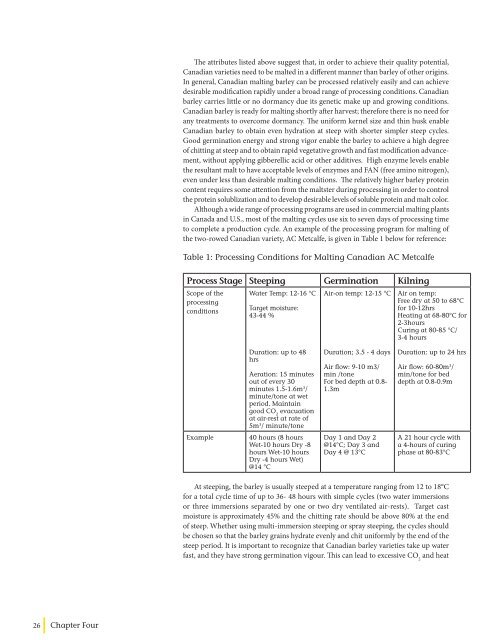MALTING QUALITY TRAITS - Canadian Malting Barley Technical ...
MALTING QUALITY TRAITS - Canadian Malting Barley Technical ...
MALTING QUALITY TRAITS - Canadian Malting Barley Technical ...
You also want an ePaper? Increase the reach of your titles
YUMPU automatically turns print PDFs into web optimized ePapers that Google loves.
26<br />
Chapter Four<br />
The attributes listed above suggest that, in order to achieve their quality potential,<br />
<strong>Canadian</strong> varieties need to be malted in a different manner than barley of other origins.<br />
In general, <strong>Canadian</strong> malting barley can be processed relatively easily and can achieve<br />
desirable modification rapidly under a broad range of processing conditions. <strong>Canadian</strong><br />
barley carries little or no dormancy due its genetic make up and growing conditions.<br />
<strong>Canadian</strong> barley is ready for malting shortly after harvest; therefore there is no need for<br />
any treatments to overcome dormancy. The uniform kernel size and thin husk enable<br />
<strong>Canadian</strong> barley to obtain even hydration at steep with shorter simpler steep cycles.<br />
Good germination energy and strong vigor enable the barley to achieve a high degree<br />
of chitting at steep and to obtain rapid vegetative growth and fast modification advancement,<br />
without applying gibberellic acid or other additives. High enzyme levels enable<br />
the resultant malt to have acceptable levels of enzymes and FAN (free amino nitrogen),<br />
even under less than desirable malting conditions. The relatively higher barley protein<br />
content requires some attention from the maltster during processing in order to control<br />
the protein solublization and to develop desirable levels of soluble protein and malt color.<br />
Although a wide range of processing programs are used in commercial malting plants<br />
in Canada and U.S., most of the malting cycles use six to seven days of processing time<br />
to complete a production cycle. An example of the processing program for malting of<br />
the two-rowed <strong>Canadian</strong> variety, AC Metcalfe, is given in Table 1 below for reference:<br />
Table 1: Processing Conditions for <strong>Malting</strong> <strong>Canadian</strong> AC Metcalfe<br />
Process Stage Steeping Germination Kilning<br />
Scope of the<br />
processing<br />
conditions<br />
Water Temp: 12-16 °C<br />
Target moisture:<br />
43-44 %<br />
Duration: up to 48<br />
hrs<br />
Aeration: 15 minutes<br />
out of every 30<br />
minutes 1.5-1.6m 3 /<br />
minute/tone at wet<br />
period. Maintain<br />
good CO 2 evacuation<br />
at air-rest at rate of<br />
5m 3 / minute/tone<br />
Example 40 hours (8 hours<br />
Wet-10 hours Dry -8<br />
hours Wet-10 hours<br />
Dry -4 hours Wet)<br />
@14 °C<br />
Air-on temp: 12-15 °C<br />
Duration; 3.5 - 4 days<br />
Air flow: 9-10 m3/<br />
min /tone<br />
For bed depth at 0.8-<br />
1.3m<br />
Day 1 and Day 2<br />
@14°C; Day 3 and<br />
Day 4 @ 13°C<br />
Air on temp:<br />
Free dry at 50 to 68°C<br />
for 10-12hrs<br />
Heating at 68-80°C for<br />
2-3hours<br />
Curing at 80-85 °C/<br />
3-4 hours<br />
Duration: up to 24 hrs<br />
Air flow: 60-80m 3 /<br />
min/tone for bed<br />
depth at 0.8-0.9m<br />
A 21 hour cycle with<br />
a 4-hours of curing<br />
phase at 80-83°C<br />
At steeping, the barley is usually steeped at a temperature ranging from 12 to 18°C<br />
for a total cycle time of up to 36- 48 hours with simple cycles (two water immersions<br />
or three immersions separated by one or two dry ventilated air-rests). Target cast<br />
moisture is approximately 45% and the chitting rate should be above 80% at the end<br />
of steep. Whether using multi-immersion steeping or spray steeping, the cycles should<br />
be chosen so that the barley grains hydrate evenly and chit uniformly by the end of the<br />
steep period. It is important to recognize that <strong>Canadian</strong> barley varieties take up water<br />
fast, and they have strong germination vigour. This can lead to excessive CO 2 and heat


